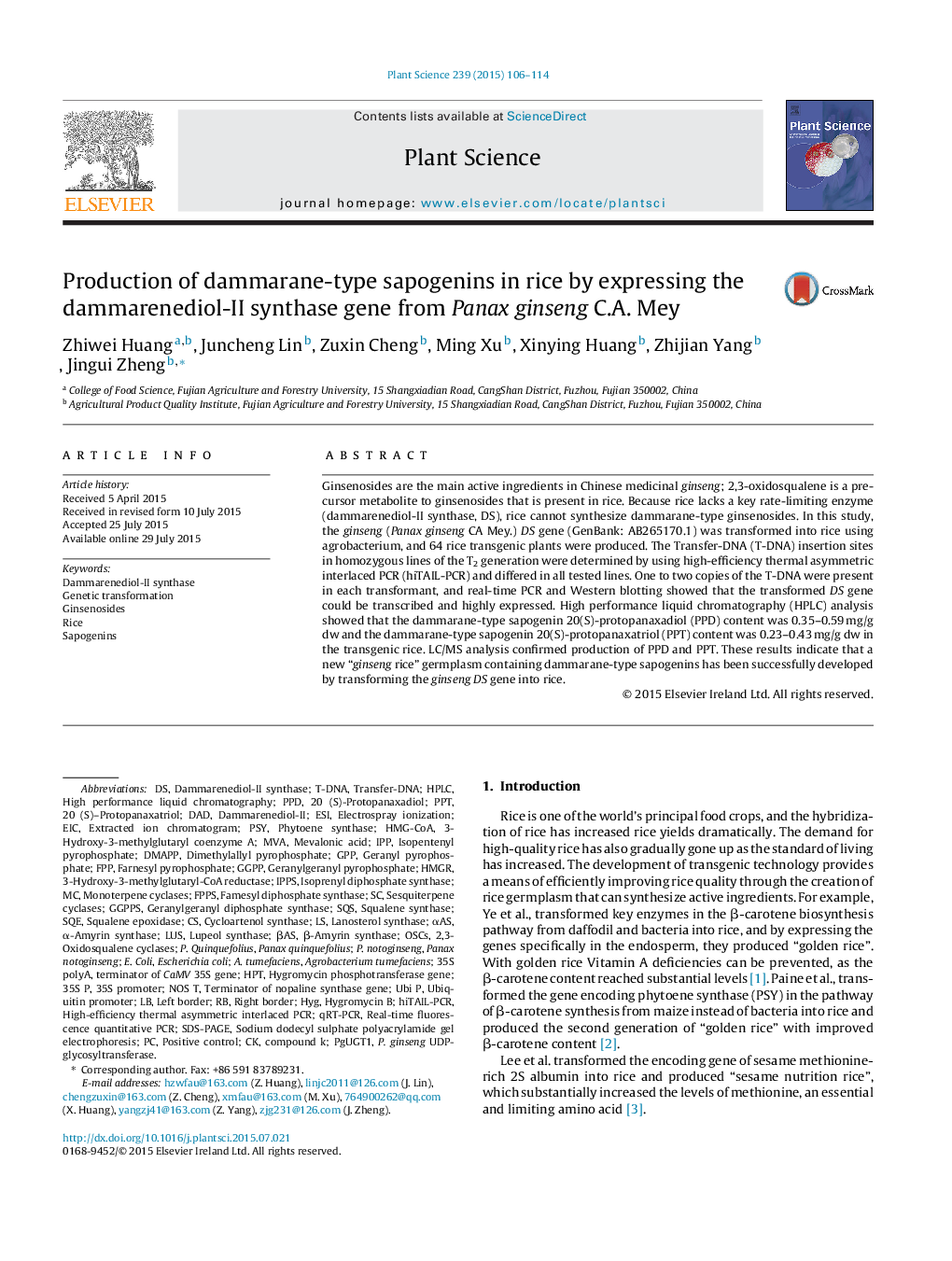| Article ID | Journal | Published Year | Pages | File Type |
|---|---|---|---|---|
| 2016986 | Plant Science | 2015 | 9 Pages |
Abstract
Ginsenosides are the main active ingredients in Chinese medicinal ginseng; 2,3-oxidosqualene is a precursor metabolite to ginsenosides that is present in rice. Because rice lacks a key rate-limiting enzyme (dammarenediol-II synthase, DS), rice cannot synthesize dammarane-type ginsenosides. In this study, the ginseng (Panax ginseng CA Mey.) DS gene (GenBank: AB265170.1) was transformed into rice using agrobacterium, and 64 rice transgenic plants were produced. The Transfer-DNA (T-DNA) insertion sites in homozygous lines of the T2 generation were determined by using high-efficiency thermal asymmetric interlaced PCR (hiTAIL-PCR) and differed in all tested lines. One to two copies of the T-DNA were present in each transformant, and real-time PCR and Western blotting showed that the transformed DS gene could be transcribed and highly expressed. High performance liquid chromatography (HPLC) analysis showed that the dammarane-type sapogenin 20(S)-protopanaxadiol (PPD) content was 0.35-0.59Â mg/g dw and the dammarane-type sapogenin 20(S)-protopanaxatriol (PPT) content was 0.23-0.43Â mg/g dw in the transgenic rice. LC/MS analysis confirmed production of PPD and PPT. These results indicate that a new “ginseng rice” germplasm containing dammarane-type sapogenins has been successfully developed by transforming the ginseng DS gene into rice.
Keywords
FPPSqRT-PCRDADIPP35S promoterhptPPDHMG-CoAGGPPHYGSQSE. coliPanax notoginsengPanax quinquefoliusPSYT-DNAReal-time fluorescence quantitative PCRSapogeninsA. tumefaciensIPPsGGPPSTransfer-DNAESIDMAPPHMGRFPPAgrobacterium tumefaciensGPPPPT3-hydroxy-3-methylglutaryl coenzyme A3-hydroxy-3-methylglutaryl-CoA reductaseOSCsLUSβ-amyrin synthasesqualene synthasesqualene epoxidaseMevalonic acidEscherichia coliSDS-PAGEsodium dodecyl sulphate polyacrylamide gel electrophoresisIsoprenyl diphosphate synthaseisopentenyl pyrophosphateRiceGenetic transformationCompound Kdimethylallyl pyrophosphatephytoene synthaseCycloartenol synthasefarnesyl pyrophosphateLanosterol synthaseMVARight borderLeft borderEICHygromycin Bgeranyl pyrophosphategeranylgeranyl pyrophosphatehygromycin phosphotransferase genehigh performance liquid chromatographyHPLCextracted ion chromatogramPositive controlGeranylgeranyl diphosphate synthaseGinsenosideselectrospray ionization
Related Topics
Life Sciences
Agricultural and Biological Sciences
Plant Science
Authors
Zhiwei Huang, Juncheng Lin, Zuxin Cheng, Ming Xu, Xinying Huang, Zhijian Yang, Jingui Zheng,
